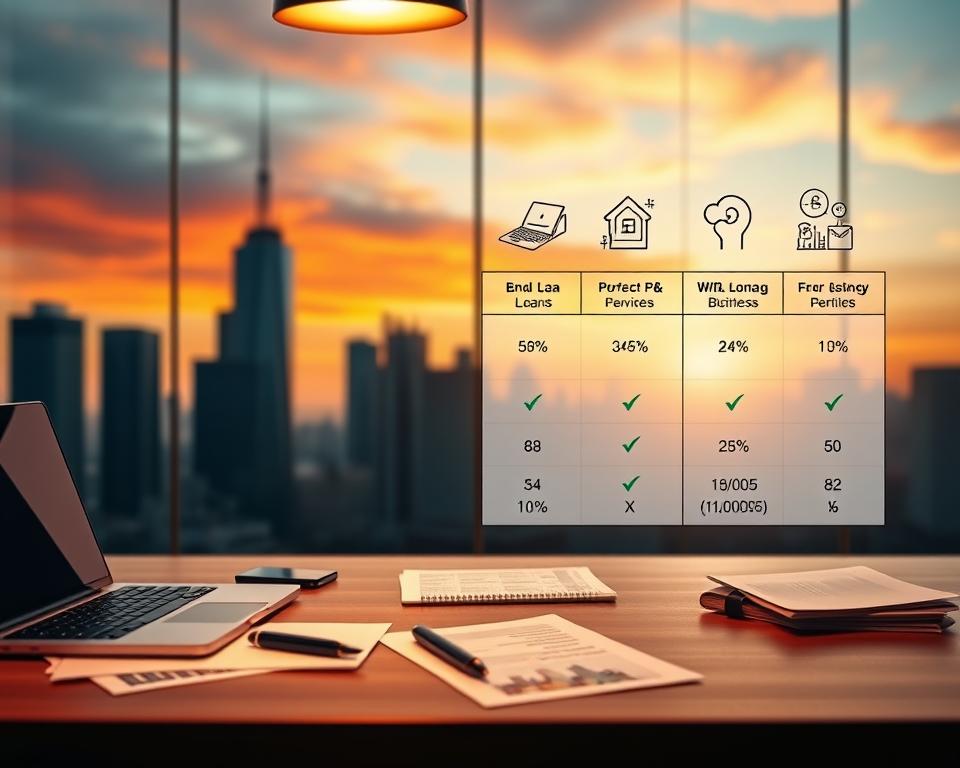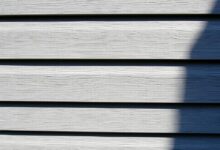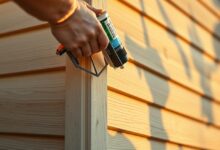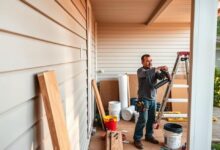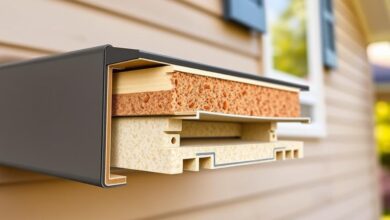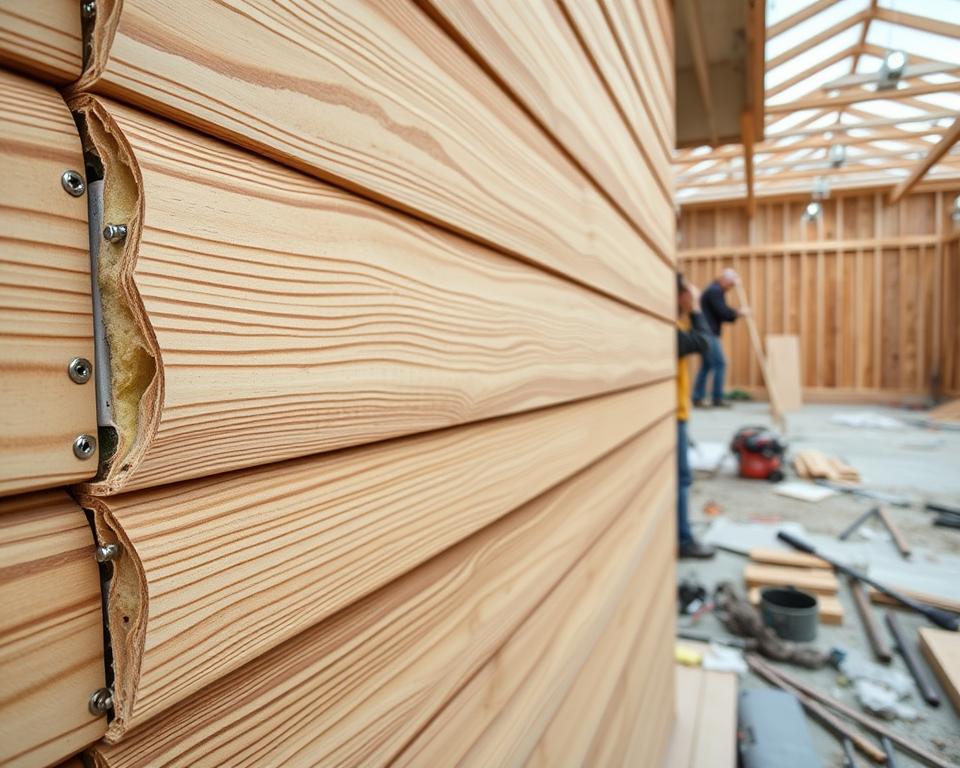Fiber Cement Insulated Siding: Durable, Energy-Efficient Protection
Homeowners are looking for durable and energy-efficient ways to protect their homes. Fiber cement insulated siding is becoming popular. It combines durability with energy efficiency.
This siding is made to last against tough weather. It means less need for repairs and replacements. Choosing energy-efficient siding also cuts down on energy costs. This makes homes more comfortable and valuable.
Key Takeaways
- Durable protection against harsh weather conditions
- Energy efficiency for reduced energy costs
- Long-lasting solution with minimal maintenance
- Enhanced home comfort and value
- Environmentally friendly option for homeowners
Understanding Fiber Cement Insulated Siding
Fiber cement insulated siding is a standout choice for exterior siding. It combines materials in a way that makes it durable and energy-efficient. This siding protects homes from the weather and helps save on energy costs.
Composition and Materials
This siding is made from cement, sand, and cellulose fibers. It also has insulation added to it. This makes it great at keeping homes cool in summer and warm in winter.
| Material | Composition | Benefits |
|---|---|---|
| Cement | Primary binder | Durability, fire resistance |
| Sand | Aggregate | Strength, texture |
| Cellulose Fibers | Reinforcement | Flexural strength, crack resistance |
How It Differs from Traditional Siding Options
Fiber cement insulated siding is different from vinyl or wood siding. It’s durable, energy-efficient, and looks good. It also doesn’t rot, get eaten by pests, or weather too much.
The insulation in the siding helps keep your home comfortable. It keeps the cold out in winter and the heat out in summer. This means you’ll use less energy and save money on bills.
Key Benefits of Fiber Cement Insulated Siding
Fiber cement insulated siding is a top pick for homeowners. It’s durable, energy-efficient, and looks great. It’s known for lasting long and making homes look better.
Durability and Weather Resistance
This siding is tough and can handle tough weather. It stands up to rain, sun, and wind. It won’t crack or crumble, even in extreme temperatures.
Energy Efficiency and Insulation Properties
This siding is also energy-smart. It keeps your home’s temperature steady. This makes your home more comfortable and saves on energy bills.
Fire Resistance and Safety Features
It’s also fire-safe. Made from non-flammable materials, it protects your home from fires. Experts say it’s a safer choice than other siding.
Aesthetic Options and Curb Appeal
It also looks good. You can choose from many textures, colors, and styles. It fits any home design, from modern to classic.
Preparing for Your Siding Project
Starting a siding project right is key. You need to get the right tools and materials, measure your home well, and decide if you’ll remove the old siding. Doing these steps well helps the installation go smoothly and saves you from expensive mistakes.
Tools and Materials Needed
You’ll need specific tools and materials for the job. This includes fiber cement insulated siding panels, a saw, a drill, and a level. You’ll also need a weather barrier and flashing to keep your home dry. Having the right tools makes the job easier.
Measuring Your Home and Calculating Materials
Getting your home’s measurements right is important. Measure each wall’s length and width, then figure out the total square footage. Remember to include windows, doors, and other features that affect siding needs. Adding 10% to your total helps cover cuts and waste.
Removing Existing Siding
Whether to remove or install over the old siding depends on several things. The condition of the current siding and local building codes are key. Removing old siding lets you check the structure and prevent future issues. But, it increases the project’s cost and labor.
Professional vs. DIY Installation Considerations
Choosing between a pro and DIY for fiber cement insulated siding is a big decision. DIY can save on labor costs but needs a lot of skill and special tools. Pros bring experience and efficiency, ensuring a quality finish. Think about your skills, budget, and the project’s complexity when deciding.
Step-by-Step Fiber Cement Insulated Siding Installation
To get a strong and energy-saving exterior, follow this guide on installing fiber cement insulated siding. This guide covers the main steps for a lasting result.
Installing Weather Barrier and Flashing
The first step is to apply a weather barrier and flashing. This layer keeps your home dry and makes the siding work well. Start by wrapping the weather barrier around your home, making sure to overlap seams by at least 6 inches. Then, add flashing around windows, doors, and openings to keep water out.
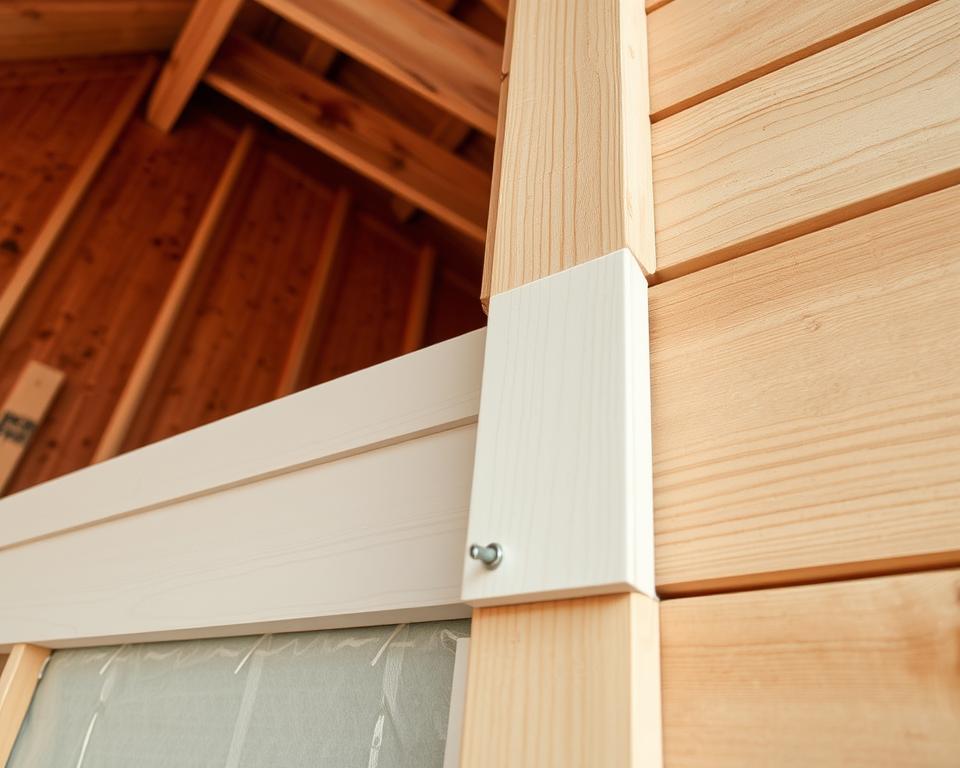
Setting Up Starter Strips and J-Channels
Next, set up starter strips and J-channels. Starter strips help nail the first siding course. J-channels go around windows and doors to hold the siding. Make sure these are level and well-fastened to the sheathing. Proper installation is key for the siding’s look and strength.
- Use a level to ensure starter strips are perfectly horizontal.
- Secure J-channels firmly around windows and doors.
Cutting and Handling Fiber Cement Panels Safely
When cutting fiber cement panels, use the right tools and safety gear. A diamond blade saw is best for clean cuts. Always wear gloves, safety glasses, and a dust mask to avoid silica dust.
“Proper safety precautions are not just recommended; they’re essential when working with fiber cement siding to avoid health risks associated with silica dust.”
Installing Panels and Insulation Layer
Start installing panels from the bottom up, making sure each is level and aligned with the starter strip. As you install, also add the insulation layer. This layer is key for energy efficiency and comfort.
| Installation Step | Description |
|---|---|
| 1. Panel Installation | Start from the bottom, ensuring each panel is level. |
| 2. Insulation Layer | Install behind the panels for energy efficiency. |
Finishing Corners, Windows, and Trim Work
The last steps are finishing corners, windows, and trim work. Use corner posts and trim to cover siding edges for a smooth look. Make sure all trim is securely fastened and sealed to protect against weather.
Key Considerations:
- Use matching trim and corner pieces for a uniform appearance.
- Seal all joints and edges to prevent water intrusion.
By following these steps, you can get a professional-looking fiber cement insulated siding installation. It will make your home stronger and more energy-efficient.
Maintenance and Cost Considerations
Keeping your fiber cement insulated siding in top shape is key. It’s not just about looks; it’s about protecting your investment. Regular care ensures your siding lasts long, stays durable, and saves energy.
Regular Cleaning and Inspection Procedures
Regular cleaning is vital for your siding’s health. Use a mild detergent and water to clean it. Also, check for damage or wear yearly to fix issues fast.
Long-Term Maintenance Requirements
Long-term care includes more than just cleaning. You should check for damage, ensure the siding is tight, and check the weather barrier and flashing. This keeps bigger problems away.
Initial Installation Costs
Installing fiber cement insulated siding might cost more at first. But, think about the long-term benefits like energy savings and lower upkeep costs. The initial cost is worth it for your home’s long-term value.
Return on Investment and Energy Savings
Fiber cement insulated siding pays off through energy savings. It cuts down on heat transfer and air leakage, saving on heating and cooling. You’ll get back a lot of what you spent on it through these savings over time.
Conclusion
Fiber cement insulated siding has many benefits. It’s durable, energy-efficient, and looks great. It keeps homes safe from the weather.
This siding helps save energy, cutting down on heating and cooling costs. It’s also fire-resistant, adding safety to homes.
Fiber cement siding comes in many styles, boosting a home’s look. It’s also easy to care for, lasting a long time. This makes it a smart choice for homeowners.
Thinking about fiber cement siding benefits helps homeowners make a good choice. It’s a top pick for improving home protection, efficiency, and value.
